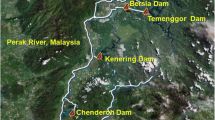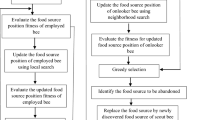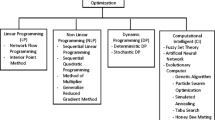Abstract
This paper presented the application of Artificial Bee Colony (ABC) and Gravitational Search Algorithm (GSA) in reservoir optimization. ABC is an algorithm based on the foraging behaviour of bee while GSA imitates the gravitational processes. These algorithms were used to minimize the irrigation release deficit for Timah Tasoh Dam located at the Northern part of Peninsular Malaysia. Results proved the superiority of the ABC compared to GSA with regards to faster convergence rate, stability, higher reliability and lower vulnerability indexes, while GSA is better in the resiliency indicator measure. Finally, both algorithms can be used to solve reservoir optimization problem with their own unique capability and to improve the performance of the reservoir compared to the existing reservoir standard operation procedure.










Similar content being viewed by others
References
Ahmad A, El-Shafie A, Razali SFM, Mohamad ZS (2014) Reservoir optimization in water resources: a review. Water Resour Manag 28(11):3391–3405
Baltar AM, Fontane DG (2008) Use of multiobjective particle swarm optimization in water resources management. J Water Resour Plann Manage 134(3):257–265
Barros MT, Tsai FT, Yang S-l, Lopes JE, Yeh WW (2003) Optimization of large-scale hydropower system operations. J Water Resour Plann Manage 129(3):178–188
Braga BP Jr, Yen WW-G, Becker L, Barros MT (1991) Stochastic optimization of multiple-reservoir-system operation. J Water Resour Plan Manag 117(4):471–481
Chang L-C, Chang F-J (2001) Intelligent control for modelling of real-time reservoir operation. Hydrol Process 15(9):1621–1634
Chang F-J, Chen L (1998) Real-coded genetic algorithm for rule-based flood control reservoir management. Water Resour Manage 12(3):185–198
Chatterjee A, Mahanti GK, Pathak NN (2010) Comparative performance of gravitational search algorithm and modified particle swarm optimization algorithm for synthesis of thinned scanned concentric ring array antenna. Progr Electromagn Res B 25:331–348
Chen L, McPhee J, Yeh WWG (2007) A diversified multiobjective GA for optimizing reservoir rule curves. Adv Water Resour 30(5):1082–1093
Crawley PD, Dandy GC (1993) Optimal operation of multiple-reservoir system. J Water Resour Plan Manag 119(1):1–17
Dariane AB, Sarani S (2013) Application of intelligent water drops algorithm in reservoir operation. Water Resour Manag 27(14):4827–4843
de Castro LN, & Timmis J (2002) An artificial immune network for multimodal function optimization. Evolutionary Computation, 2002. CEC’02. Proceedings of the 2002 Congress on, IEEE
De Meyer K, Bishop J, Nasuto S (2003) Stochastic diffusion: using recruitment for search. Evolvability and interaction: evolutionary substrates of communication, signalling, and perception in the dynamics of social complexity. In: McOwan P, Dautenhahn K, Nehaniv CL (Ed.). Technical Report 393: 60–65X
Duman S, Güvenç U, Sönmez Y, Yörükeren N (2012) Optimal power flow using gravitational search algorithm. Energy Convers Manag 59:86–95
Eberhart R, Kennedy J (1995) A new optimizer using particle swarm theory. Micro Machine and Human Science, 1995. MHS’95. Proceedings of the Sixth International Symposium on, IEEE
Fayaed S, El-Shafie A, Jaafar O (2013) Integrated Artificial Neural Network (ANN) and Stochastic Dynamic Programming (SDP) model for optimal release policy. Water Resour Manag 27(10):3679–3696
Gomez A, Salhi S (2014) Solving capacitated vehicle routing problem by artificial bee colony algorithm. Computational Intelligence in Production and Logistics Systems (CIPLS), 2014 I.E. Symposium on, IEEE
Guo Z (2012) A hybrid optimization algorithm based on artificial bee colony and gravitational search algorithm. Int J Digital Content Technol Appl 6(17)
Hashimoto T, Stedinger JR, Loucks DP (1982) Reliability, resiliency, and vulnerability criteria for water resource system performance evaluation. Water Resour Res 18(1):14–20
Hossain MS, El-shafie A (2013) Intelligent systems in optimizing reservoir operation policy: a review. Water Resour Manag 27(9):3387–3407
Karaboga N (2009) A new design method based on artificial bee colony algorithm for digital IIR filters. J Franklin Inst 346(4):328–348
Karaboga D, Akay B (2009) A comparative study of Artificial Bee Colony algorithm. Appl Math Comput 214(1):108–132
Karaboga D, Basturk B (2007) A powerful and efficient algorithm for numerical function optimization: artificial bee colony (ABC) algorithm. J Glob Optim 39(3):459–471
Karaboga D, Basturk B (2008) On the performance of artificial bee colony (ABC) algorithm. Appl Soft Comput 8(1):687–697
Kumar ARS, Goyal M, Ojha CSP, Singh RD, Swamee PK, Nema RK (2013) Application of ANN, fuzzy logic and decision tree algorithms for the development of reservoir operating rules. Water Resour Manag 27(3):911–925
Li X-G, Wei X (2007) An improved genetic algorithm-simulated annealing hybrid algorithm for the optimization of multiple reservoirs. Water Resour Manag 22(8):1031–1049
Loucks DP, Van Beek E, Stedinger JR, Dijkman JP, Villars MT (2005) Water resources systems planning and management: an introduction to methods, models and applications. UNESCO, Paris
Mandal SK, Chan FT, Tiwari M (2012) Leak detection of pipeline: an integrated approach of rough set theory and artificial bee colony trained SVM. Expert Syst Appl 39(3):3071–3080
Mays LW, Tung Y-K (1992). Hydrosystems engineering & management. McGraw Hill
Meraji SH, Afshar M, Afshar A (2005) Reservoir operation by particle swarm optimization algorithm. Proceedings of the 7th International Conference of Civil Engineering (Icce7th), Tehran, Iran
Molga M, Smutnicki C (2005) Test functions for optimization needs. North-Eastern Hill University, Shillong
Omar N, Eng Chieh O, Adam A, Hasim SH, Zainal Abidin AF, Jaafar HI, Zakaria H, Jefery H, Nordin NA, Khairuddin O (2014) An experimental study of the application of gravitational search algorithm in solving route optimization problem for holes drilling process. International Conference Recent Treads in Engineering & Technology, Batam, 7–10
Ozturk A, Cobanli S, Erdogmus P, Tosun S (2010) Reactive power optimization with artificial bee colony algorithm. Sci Res Essays 5(19):2848–2857
Pasha MFK, Yeasmin D, Rentch JW (2015) Dam-lake operation to optimize fish habitat. Environ Process 2(4):631–645
Rao RS, Narasimham SVL, Ramalinga Raju M, Srinivasa Rao A (2011) Optimal network reconfiguration of large-scale distribution system using harmony search algorithm. IEEE Trans Power Syst 26(3):1080–1088
Rashedi E, Nezamabadi-Pour H, Saryazdi S, Farsangi MM (2007) Allocation of static var compensator using gravitational search algorithm. First Joint Congress on Fuzzy and Intelligent Systems, Iran
Rashedi E, Nezamabadi-Pour H, Saryazdi S (2009) GSA: a gravitational search algorithm. Inf Sci 179(13):2232–2248
Rashedi E, Nezamabadi-pour H, Saryazdi S (2011) Filter modeling using gravitational search algorithm. Eng Appl Artif Intell 24(1):117–122
Reddy MJ, Nagesh Kumar D (2007) Multi-objective particle swarm optimization for generating optimal trade-offs in reservoir operation. Hydrol Process 21(21):2897–2909
Sabat SL, Udgata SK, Abraham A (2010) Artificial bee colony algorithm for small signal model parameter extraction of MESFET. Eng Appl Artif Intell 23(5):689–694
Shah Hosseini H (2007) Problem solving by intelligent water drops. Evolutionary Computation, 2007. CEC 2007. IEEE Congress on, IEEE
Van Loon A, Van Lanen H (2015) Testing the observation-modelling framework to distinguish between hydrological drought and water scarcity in case studies around Europe
Walker WE, Loucks DP, Carr G (2015) Social responses to water management decisions. Environ Process 2(3):485–509
Wardlaw R, Sharif M (1999) Evaluation of genetic algorithms for optimal reservoir system operation. J Water Resour Plan Manag 125(1):25–33
Author information
Authors and Affiliations
Corresponding author
Rights and permissions
About this article
Cite this article
Ahmad, A., Razali, S.F.M., Mohamed, Z.S. et al. The Application of Artificial Bee Colony and Gravitational Search Algorithm in Reservoir Optimization. Water Resour Manage 30, 2497–2516 (2016). https://doi.org/10.1007/s11269-016-1304-z
Received:
Accepted:
Published:
Issue Date:
DOI: https://doi.org/10.1007/s11269-016-1304-z




